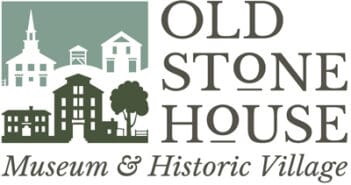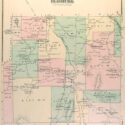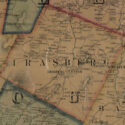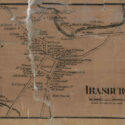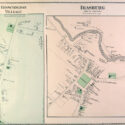Town Facts:
- Granted: 1781, to Ira Allen and his associates.
- First settler: Caleb Leach, ca. 1798.
- The Allens and other proprietors leased land to settlers. No lands conveyed by deed until Ira H. Allen, son of Ira Allen, became town resident in 1814.
- Was once known as Irasburgh.
- Became Orleans County shire town in 1812. Was so until Newport became shire town in 1886.First courthouse and jail built in 1815- by Irasburgh residents at their expense. The original courthouse moved in 1847 and a new one was built on the same site. Original timber jail was replaced by a stone one in 1838, which in turn was replaced by a granite one in 1862.
- Capt. James Richardson, who settled there in 1803, opened first tavern in town.
- Production of salts and pearl-ashes was primary industry in first decade of 19th century. These transported to Canada, despite the embargo. A large amount of smuggling by town residents at that time.
- Mills and distillery as early as 1810.
- In 1820s, the town prospered and new industrial sites arose, including woolen mill, tannery, and foundry producing stoves and plows.
- E. & T. Fairbanks & Company forced an Irasburgh scale company to stop business because it infringed on their rights.
From the Vermont Historical Gazetteer, edited by Abby Maria Hemenway. Orleans County – Irasburgh Chapter: By E. P Colton. Published by Claremont Manufacturing Co, 1877. Pgs 239-260.
IRASBURGH.
The township of Irasburgh was granted to Ira Allen and his associates, by the General Assembly of Vermont on the 23rd day of Feb. 1781. The 43 others whose names appear as his associates were the names of individuals living at a distance or were fictitious.
The unappropriated lands in Vermont, at this time were claimed by New Hampshire and New York, and the Continental Congress had ordered the Assembly of the “So called State of Vermont,” not to grant any more lands within its jurisdiction, until the controversy between the inhabitants of the “So called State of Vermont, ” and New York and New Hampshire should be settled. The Legislature at this time was what would now be called bogus, that is, it was so considered by a large portion of the people in the United Colonies.
The Assembly of Vermont paid no attention to the order of Congress, nor to the threats of New York, but granted lands as long as there was an acre unappropriated. The people were democratic and were opposed to there being large landed proprietors within the bounds of the State, so the townships were granted to from 40 to 70 individuals, conditioned that each proprietor could make improvements on his individual right within a specified time.
There was reserved, for public and pious uses forever, five equal rights, viz. One right for the use of a college within this State; one for the benefit of the first settled minister; one for the use and support of the ministry in said township; one for the support of county grammar schools; and one for the support of an English School or Schools in said township forever.
The township was granted 6 miles square, bounded N. by Coventry, S. by Lutterloh. The lauds on the east and west sides were at this time unappropriated and unnamed. There were in the grant the following reservations and conditions that each proprietor, his heirs or assigns, should plant and cultivate 5 acres of land, and build a house at least 18 feet square, or have one family settled on each respective right within 4 years from the time of establishing the outlines of said township, on penalty of the forfeiture of each respective right not so settled and improved, as aforesaid, and the same to revert to the freemen of this State, to be, by their representatives, regranted to such persons as shall appear to settle and cultivate the same.
Previous to 1789, Ira Allen had received conveyances from all of the original proprietors, so that the whole township, except the public rights, belonged to him, subject to the conditions of the grant, and Sept. 13, 1789, Ira Allen conveyed all his rights in the township of Irasburgh to Jerusha Enos jr., of Hartland, as a marriage dower.
The Legislature of the State, at their session in 1797, assessed a tax of three cents per acre on all lands in Irasburgh (public rights excepted) for the purpose of repairing roads and building bridges. The lands were all sold, and again bid off by Heman Allen, who became owner by virtue of vendue deeds from two collectors, authorized to convey them by statute laws, Ira, and Jerusha Allen had, previous to these sales leased several lots in town to various individuals, some of whom were occupying them at this time. The leases were perpetual, conditioned that the lessee pay, after 5 years, a rent, of 5 cents per acre, increasing each year 3 cents per acre, until the sum amounted to 17 cents per acre which should be the annual rent payable to Elijah Paine and Heman Allen on the first day of January of each year. The leases were forfeited in case any taxes were unpaid, or if the annual rents were six months in arrears.
Heman Allen was one of the trustees who collected the rents for Jerusha Allen ; and, after he became legal owner of the town, by virtue of vendue deeds, he caused the occupants of lands, who held them under leases from Ira and Jerusha Allen, to quit-claim their lots to him, who again leased to them in his own name. After the vendue sales in 1803, some doubt as to the legality of the proceedings of the previous proprietors’ meetings existed in minds of those interested, and they succeeded in getting a special enabling act passed at the session of the general assembly in October 1804.
Those residents, who were in town at that time could probably hold their lands against all the Allens, had they known how the business had been transacted, but Heman Allen, Roger Enos jr., and Esq. Ralph Parker managed the business for Jerusha Allen so that in the end she became the sole owner of the whole town except the public rights. Settlers held their lands under leases, and it was not till Ira H. Allen became a resident of the town that any lands were conveyed by deed. Roger Enos jr., Jerusha Enos and Jerusha Enos jr., the wife of Ira Allen were the only three of the original proprietors named in the grant who ever resided in town.
SETTLEMENT.
The first settlement made in town (or the first settler recognized [sic] as such by Heman Allen) was made by Caleb Leach on lot No. 108, now owned by Mr. John L. Dodge. This lot is in the east part of the town and lies on the Barton line. Mr. Leach erected a log house a little west of where Mr. Dodge’s orchard now stands, and brought his family here in 1798. James Leach came soon after and commenced on Lot 109 now occupied by Mr. Jesse Alden, Levi Sylvester was here when found in 1799, on lot No. 162, now owned by Mr. Leach and known as the brick house-farm.
Mr Leach’s and Mr. Levi Sylvester’s were the only families here when the census was taken in 1800, the population at that time being 15. During this year Foster Page, Simon French, Orlander Bowley, Amos Conant and his son Samuel made settlements in town.
It is not known how many men moved into town daring the years 1801 and 1802, the only records showing that any intended to settle are the dates of leases from Ira and Jerusha Allen to various individuals, some of whom settled here in 1803-4 and 5. Nearly every lot in the east and north-east part of the town was leased during these years. It appears that the proprietors leased lots to men who had never seen them, because several of the lots leased in 1802 are wild and unimproved at this time. Among those who took leases during the years, 1802 and ’03 were the Bartons, Morrells, Baileys, Curriers, Utleys and Peter Thatcher, and some others who became residents of the town for many years.
Feb. 13, 1803, Foster Page, Caleb Leach, Levi Sylvester, James Leach and Simon French, signed a petition [to] notify all the inhabitants who were legal voters to meet and organize the town. This year Ralph Parker, Esq., of Glover built a grist and sawmill on the site of the present flouring mill. These mills were both under one roof- the sawmill tending up towards the dam occupying the site of the present flume. These mills were built by Parker for the Allens, and the property has always been in the family till September, 1869, when it was conveyed by Charles P. Allen to Sumner Chilson.
This year Capt. James Richardson settled on lot No. 80, now owned by Daniel Houghton. His buildings were a hundred rods farther up the hill than Mr. Houghton’s dwelling. A few years after, roads were opened by his place- one over from Amos Conant’s, His buildings stood at four corners, and he kept the first tavern opened in town. The house was located on one of the great highways, leading north through the County. What was one of the important points from 1804 to 1812 is now an old pasture with no road within half a mile.
In the autumn of this year Benj. Burton settled on lot No. 179, which gave the name to that part of the town now known as Burton hill. Sargent Morrell located his family on lot No. 32, now owned by Mr. Post, and his son Jeremiah selected lot No. 41, adjoining. These men gave the name of Morrell hill to that part of the town. A man by the name of McFarland located on lot No. 113, now known as the Allen Farm, having been the home-place of Ira H. Allen for many years.
Roads were opened from Caleb Leech’s to Parker’s mills, passing McFarland’s; also one from Burton hill to Capt. Richardson’s, passing this place, and another from Amos Conant’s to McFarland’s, making five corners. This place was thought, at that time, to be the spot on which the village would be located – Town and religious meetings were held here in 1810, when Eber Burton built a large framehouse near the common.
A burying-ground was established on the hard, gravelly knoll on the top of the hill north of the road. The militia of the town held their annual June trainings at this place, for several years. This was the business centre till the old court-house was completed in 1816.
In 1806, there was a great increase in the population by immigration. This year the town was divided into two school districts, called the north and south districts. The north district comprised all that part of the town north of Caleb Leach’s, and the south district comprised Burton bill and all the town west. There were reported March 30, 1807, 60 scholars in the north district, and 33 in the south district Miss Fanny Kellam, daughter of Dea. Kellam, taught the first school. This school was taught in a barn on Burton hill.
In the spring of 1808, a large quantity of pearlash remained in the country, and Barton river was cleared out, the casks put on to rafts and barges, and transported by water to Quebec. This circumstance gave the name of “the landing” to that part of Barton near Irasburgh line where the merchandize was put on board the boats. The principal business of the inhabitants, at this time, was the making of salts and pearl-ashes, which were taken, in winter, on ox-sleds to Missisquoi Bay and Montreal.
Those portions of the town which were timbered with maple and elm were first settled because those kinds of wood yield more ashes, and will burn with less trouble than many other kinds. These times also encouraged smuggling which was carried on by residents of the town to considerable extent.
The west part of the town settled more slowly than the other parts, because there was more dark timber in that section, which always frightened the early settlers. In 1810, the population had increased to 392, which was nearly all on the east side of the river.
Something was done at manufacturing about this time. Ezekiel Currier had erected a distillery on lot No. 88. Potato whisky used to sell, at the still, at 50 cents per gallon. Abraham Gale made fanning-mills, and Samuel Wells ran a spinning-jenny. John Adams was the first carpenter who worked by the square rule. Walter Derby was the first blacksmith, and had a shop on the top of what was called the mill hill, where Mr. Pearsons now has a garden. Eber Burton opened a small store in a building that stood where Dr. Parkhurst now resides. There was a store on the Sol. Eaton place on Burton hill when goods were sold in exchange for salts and pearlash.
The war of 1812, was declared while the people in Irasburgh were making salts and whiskey and smuggling goods from Canada. An association had formed consisting of a dozen or more men who gave a joint and several note to Wm. Baxter of Brownington for funds which they used in the smuggling business. This ring was not broken up till 1814, when an association of anti-smugglers, who worked for their own interest, frustrated all their plans and overpowered them.
During this year the first framed house was put up in what is now the village, by Eber Burton. This house is still standing and in a good state of preservation. It was used many years as a hotel.
In 1812, the Legislature of the State passed an act constituting Irasburgh the Shire-town of Orleans County, provided the inhabitants of Irasburgh would erect a court-house and jail at their own expense. Nothing appears to have been done towards erecting buildings, till after Ira H. Allen came here in 1814. The buildings were put up in 1815, and completed so that the courts were held here 1816. The old court-house was moved in 1847, and a new one erected upon the site, which cost nearly $4000, which was also built by the town at no expense to the County. The first jail was built of logs or hewn timber, ceiled with three-inch hardwood plank. This structure stood till 1838, when it was taken down and a stone structure erected on its site. This jail was 18 feet square on the ground, two stories high. It was found to be too small, at many times, and was not considered safe for desperate characters; so, upon recommendation of the members from Orleans County, the Legislature in 1861 authorized the County judges to borrow $3000 for the purpose of erecting a new jail. Harry Hinman, Jonathan Elkins and E. P.
Colton, were appointed a committee by the legislature to rebuild. The new jail was erected in 1862, and is one of the safest, best constructed buildings of the kind in the country. It is 26 by 36 ft on the ground, two stories high, and built of the best of granite.
The principal business of the inhabitants, during the war, seems to have been, one party taking cattle and contraband goods from the other party. Roger Enos, Ezekiel Little and Jos. Kidder were deputy collectors of customs, and with their friends and retainers were continually alert for smugglers.
The government party became strongest, and many of those who engaged in smuggling became bankrupt and left the town. Some families went away during the war, and never returned-, many went West during the decade from 1810 to ’20; so that there were but an increase of 40 inhabitants in the 10 years. From 1820 to 1830, the population more than doubled; it was a decade of great prosperity for the town.
Ezekiel Little built a saw-mill on the river above the old mills, and Sylvester Howard put in a tannery at that place. Roger Enos erected a factory for the manufacture of woolens, which stood opposite the grist-mill. A foundry was also built here, and a company formed for the purpose of manufacturing scales. They infringed upon the rights of E. & T. Fairbanks t Co., who compelled them to stop business. The foundry was used, for many years, for the manufacture of stoves and plows.
BANKS.
“The Bank of Orleans ” was chartered in 1830, and went into operation soon after that time. The presidents have been Ira H. Allen, Elijah Cleveland and Hiram McLellan; the cashiers-George C. West, Henry M. Bates, Isaac N. Cushman and Wm. B. Denison. The Bank is now ” The Irasburg National Bank of Orleans.” The Bank of Orleans was the first Bank established in the County.
NEWSPAPERS PUBLISHED IN IRASBURGH.
In 1845, Mr. E. Rawson established THE YEOMAN’S RECORD, which was the first paper published in the County. Efforts were made by the friends of the enterprise to get a list of subscribers which would pay for publishing and about 150 subscribers were obtained during the first year, which was about the average number during the 5 years of the life of the paper. The sheet was neutral in politics, and its columns were open to all parties ; and Whigs, Democrats and Liberty men used it for the expression of their various opinions. In 1848, Mr. Rawson sold his interest in the paper to Mr. A. G. Conant, who published it for a few months and then resold to Mr. Rawson, who published till 1850, when it died for want of sufficient suuport.
In the year 1850, the Messrs. L. B. & J. L. Jameson commenced the publication of the Orleans County Gazette, which was Whig in politics. The Messrs. Jamesons disposed of their interest to Mr. Jas. M. Dana, who published about 2 years, and sold to Mr. George H. Hartshorn, who published 1 year, and then sold one half the interest to Sylvester Howard. Hartshorn and Howard were the owners a few months, when the firm was changed to Earle and Howard. After 3 months another change put the names of Howard and Morris at the head of the columns. This firm was of short duration. Mr. Morris sold his interest to Mr. Howard, who in the fall of 1855, sold out the whole concern to the proprietors of “The North Union,” a paper then published at West Charleston.
In January, 1856, Mr. Earle commenced the publication of The Independent Standard which he published in this place for 10 years, when he moved to Barton where he is now located.
In 1861, The Green Mountain Express was started by H. & G. H. Bradford, who published for nearly 1 year, when they abandoned the enterprise. To Mr. Earle, is the County indebted, more than to any other man or men, for the size and value of the County papers at this time. He is the father of journalism in this County.
THE CONGREGATIONAL CHURCH IN IRASBURGH, BY DEACON JAMES CLEMENT.
On the 18th day of Jan. 1818, the Rev. James Hobart, of Berlin, Vt. and Rev. Luther Leland of Derby organized the Congregational Church in Irasburg, according to usage, consisting of 3 male and 5 female members. These persons, although coming from different localities, were similar in their opinions and practices, and immediately felt the importance of Christian union. For the next 3 years they were without a minister, except occasionally a missionary lectured or preached on the Sabbath. One of them, a Mr. Worcester, delivered a lecture on March Meeting day at the court-house. About the middle of his discourse a man started for the door exclaiming, ” I do not believe a word of that.” Mr. W. stopped a moment and said, “If there is another indecent person in the room, I wish they would leave, ” but no one else left. Among the number that preached here occasionally during this time, were the Rev. Messrs. David Sutherland of Bath, N. H., Leland of Derby, Hobart of Berlin, and Parker. The church had no house for worship at that time, but held their meetings in the court house and village schoolhouse. At this time there was each a Baptist and Methodist church here. In 1839, the Congregational Society built their present meetinghouse which was dedicated in January, 1840.
